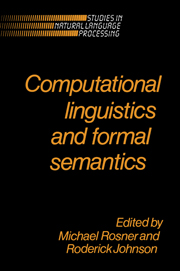Book contents
- Frontmatter
- Contents
- List of contributors
- Preface
- 1 Unification
- 2 Representations and interpretations
- 3 Syntactic categories and semantic type
- 4 Fine-structure in categorial semantics
- 5 Properties, propositions and semantic theory
- 6 Algorithms for semantic interpretation
- 7 Situation schemata and linguistic representation
- 8 Application-oriented computational semantics
- 9 Form and content in semantics
- 10 Epilogue: on the relation between computational linguistics and formal semantics
- Bibliography
4 - Fine-structure in categorial semantics
Published online by Cambridge University Press: 05 June 2012
- Frontmatter
- Contents
- List of contributors
- Preface
- 1 Unification
- 2 Representations and interpretations
- 3 Syntactic categories and semantic type
- 4 Fine-structure in categorial semantics
- 5 Properties, propositions and semantic theory
- 6 Algorithms for semantic interpretation
- 7 Situation schemata and linguistic representation
- 8 Application-oriented computational semantics
- 9 Form and content in semantics
- 10 Epilogue: on the relation between computational linguistics and formal semantics
- Bibliography
Summary
INTRODUCTION
In the linguistic study of syntax, various formats have been developed for measuring the combinatorial power of natural languages. In particular, there is Chomsky's well-known hierarchy of grammars which can be employed to calibrate syntactic complexity. No similar tradition exists in linguistic semantics, however. Existing powerful formalisms for stating truth conditions, such as Montague Semantics, are usually presented as monoliths like Set Theory or Intensional Type Theory, without any obvious way of expressive fine-tuning. The purpose of this chapter is to show how semantics has its fine-structure too, when viewed from a proper logical angle.
The framework used to demonstrate this claim is that of Categorial Grammar (see Buszkowski et al. [24] or Oehrle et al. [173] for details). In this linguistic paradigm, syntactic sensitivity resides in the landscape of logical calculi of implication, which manipulate functional types as conditional propositions. The landscape starts from a classical Ajdukiewicz system with modus ponens only and then ascends to intuitionistic conditional logic, which allows also subproofs with conditionalisation. A well-known intermediate system is the Lambek Calculus (Moortgat [156], van Benthem [232]), which takes special care in handling occurrences of propositions or types. These calculi represent various ‘engines’ for driving categorial parsing, which can be studied as to their formal properties by employing the tools of logical proof theory.
- Type
- Chapter
- Information
- Computational Linguistics and Formal Semantics , pp. 127 - 158Publisher: Cambridge University PressPrint publication year: 1992

